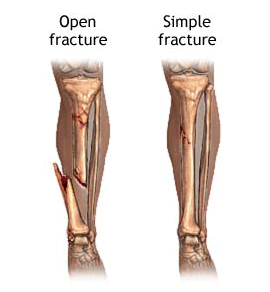First Aid – Fractures
A fracture is a broken or cracked bone. For first aid purposes fractures can be divided into two classifications:

- Open (compound) fracture. The bone is broken and an open wound is present. Often the end of the broken bone may protrude from the wound.
- Closed (simple) fracture. No open wound is present, but there is a broken or cracked bone.
Broken bones, especially the long bones of the upper and lower extremities, often have sharp, sawtooth edges; even slight movement may cause the sharp edges to cut into blood vessels, nerves, or muscles, and perhaps through the skin. Careless or improper handling can convert a closed fracture into an open fracture, causing damage to surrounding blood vessels or nerves which can make the injury much more serious. A person handling a fracture should always keep this in mind. Damage due to careless handling of a closed fracture may greatly increase pain and shock, cause complications that will prolong the period of disability, and endanger life through hemorrhage of surrounding blood vessels.
If the broken ends of the bone extend through an open wound, there is little doubt that the victim has suffered a fracture. However, the bone does not always extend through the skin, so the person administering first aid must be able to recognize other signs that a fracture exists.
The general signs and symptoms of a fracture are as follows:
- Pain or tenderness in the region of the fracture
- Deformity or irregularity of the affected area
- Loss of function (disability) of the affected area
- Moderate or severe swelling
- Discoloration
- Victim’s information, if conscious (the victim may have felt the bone snap or break)
Be careful when examining injured persons, particularly those apparently suffering from fractures. For all fractures the first aider must remember to maintain an open airway, control bleeding and treat for shock. Do not attempt to change the position of an injured person until he/she has been examined and it has been determined that movement will not complicate the injuries. If the victim is lying down, it is far better to attend to the injuries with the victim in that position and with as little movement as possible. If fractures are present, make any necessary movement in such a manner as to protect the injured part against further injury.
Splints
Use splints to support, immobilize, and protect parts with injuries such as known or suspected fractures, dislocations or severe sprains. When in doubt, treat the injury as a fracture and splint it. Splints prevent movement at the area of the injury and at the nearest joints. Splints should immobilize and support the joint or bones above and below the break.
Many types of splints are available commercially. Easily applied and quickly inflated plastic splints give support to injured limbs. Improvised splints may be made from pieces of wood, broom handles, newspapers, heavy cardboard, boards, magazines, or similar firm materials.
Certain guidelines should be followed when splinting:
- Gently remove all clothing from any suspected fracture or dislocation.
- Do not attempt to push bones back through an open wound.
- Do not attempt to straighten any fracture.
- Cover open wounds with a sterile dressing before splinting.
- Pad splints with soft material to prevent excessive pressure on the affected area and to aid in supporting the injured part.
- Pad under all natural arches of the body such as the knee and wrist.
- Support the injured part while splint is being applied.
- Splint firmly, but not so tightly as to interfere with circulation or cause undue pain.
- Support fracture or dislocation before transporting victim.
- Elevate the injured part and apply ice when possible.
A break in the lower part of the leg requires two splints, one on each side of the leg (or at least the shin). If suitable material is not available, you can use the victim’s healthy leg as a makeshift splint.
As much as possible, keep the victim from moving and until an ambulance arrives, remember ICE:
- “I” is for ice – if possible apply an ice pack or ice cubes to the injured area. This will keep down the swelling and reduce pain.
- “C” is for compression – if the wound is bleeding, apply direct pressure with a clean cloth to reduce blood flow.
- “E” is for elevation – try to keep the injured area as high above heart level as possible. This will reduce blood flow to the injury and minimize swelling.